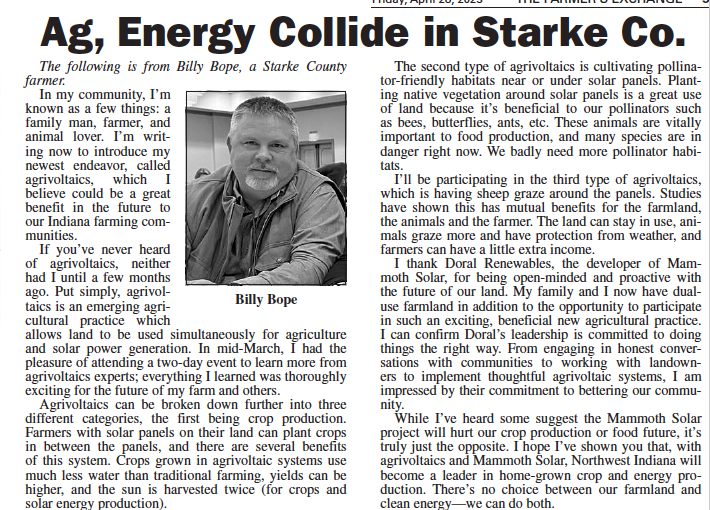Ag, Energy Collide in Starke Co., Creating a Bright Future for Northwest Indiana
An Op-Ed by Billy Bope, Landowner, Mammoth North Solar

In my community, I’m known as a few things: a family man, farmer, and animal lover. I’m writing now to introduce my newest endeavor, called agrivoltaics, which I believe could be a great benefit in the future to our Indiana farming communities.
If you’ve never heard of agrivoltaics, neither had I until a few months ago. Put simply, agrivoltaics is an emerging agricultural practice which allows land to be used simultaneously for agriculture and solar power generation. In mid-March, I had the pleasure of attending a two-day event to learn more from agrivoltaics experts; everything I learned was thoroughly exciting for the future of my farm and others.
Agrivoltaics can be broken down further into three different categories, the first being crop production. Farmers with solar panels on their land can plant crops in between the panels, and there are several benefits of this system. Crops grown in agrivoltaic systems use much less water than traditional farming, yields can be higher, and the sun is harvested twice (for crops and solar energy production. The second type of agrivoltaics is cultivating pollinator-friendly habitats near or under solar panels. Planting native vegetation around solar panels is a great use of land because it’s beneficial to our pollinators such as bees, butterflies, ants, etc. These animals are vitally important to food production, and many species are in danger right now. We badly need more pollinator habitats.
I’ll be participating in the third type of agrivoltaics, which is having sheep graze around the panels. Studies have shown this has mutual benefits for the farmland, the animals, and the farmer. The land can stay in use, animals graze more and have protection from weather, and farmers can have a little extra income.
I thank Doral Renewables, the developer of Mammoth Solar, for being open-minded and proactive with the future of our land. My family and I now have dual-use farmland in addition to the opportunity to participate in such an exciting, beneficial new agricultural practice. I can confirm Doral’s leadership is committed to doing things the right way. From engaging in honest conversations with communities to working with landowners to implement thoughtful agrivoltaic systems, I am impressed by their commitment to bettering our community.
While I’ve heard some suggest the Mammoth Solar project will hurt our crop production or food future – it’s truly just the opposite. I hope I’ve shown you that, with agrivoltaics and Mammoth Solar, northwest Indiana will become a leader in homegrown crop and energy production. There’s no choice between our farmland and clean energy – we can do both.



